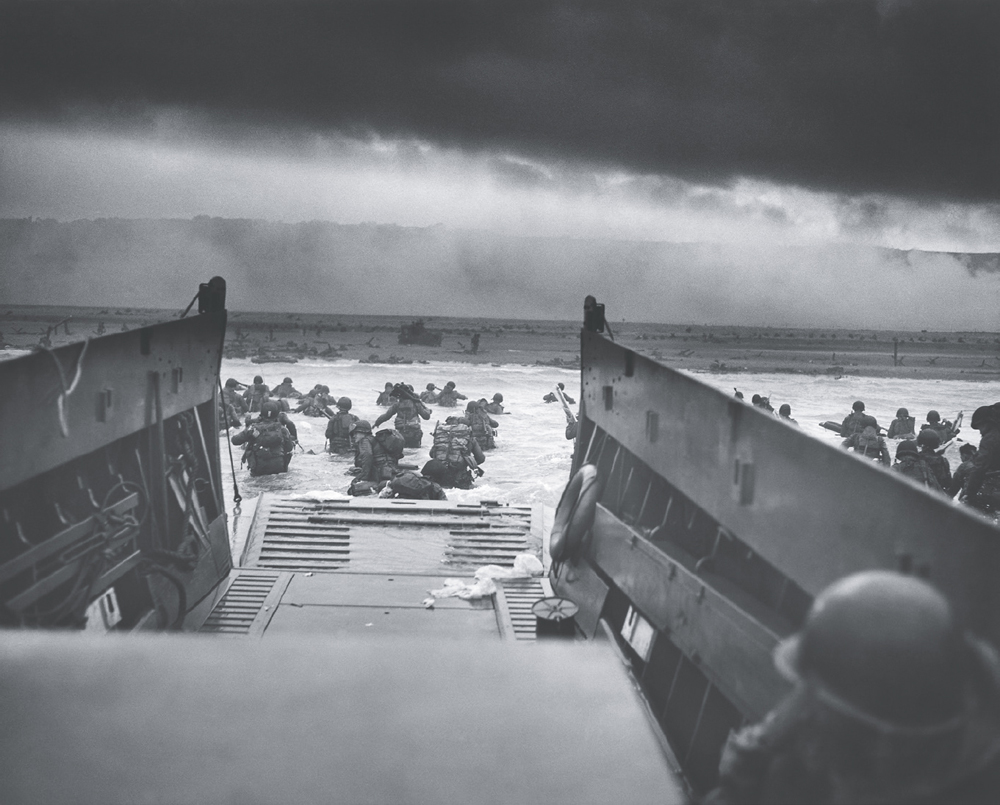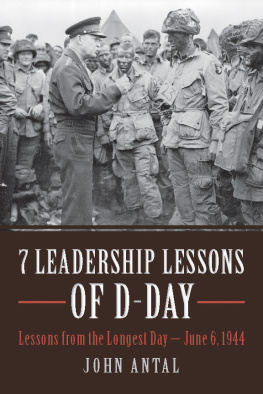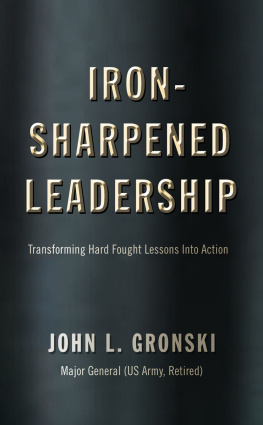John Antal - 7 Leadership Lessons of D-Day
Here you can read online John Antal - 7 Leadership Lessons of D-Day full text of the book (entire story) in english for free. Download pdf and epub, get meaning, cover and reviews about this ebook. year: 2017, publisher: Casemate Publishers & Book Distributors, LLC, genre: History. Description of the work, (preface) as well as reviews are available. Best literature library LitArk.com created for fans of good reading and offers a wide selection of genres:
Romance novel
Science fiction
Adventure
Detective
Science
History
Home and family
Prose
Art
Politics
Computer
Non-fiction
Religion
Business
Children
Humor
Choose a favorite category and find really read worthwhile books. Enjoy immersion in the world of imagination, feel the emotions of the characters or learn something new for yourself, make an fascinating discovery.
- Book:7 Leadership Lessons of D-Day
- Author:
- Publisher:Casemate Publishers & Book Distributors, LLC
- Genre:
- Year:2017
- Rating:4 / 5
- Favourites:Add to favourites
- Your mark:
- 80
- 1
- 2
- 3
- 4
- 5
7 Leadership Lessons of D-Day: summary, description and annotation
We offer to read an annotation, description, summary or preface (depends on what the author of the book "7 Leadership Lessons of D-Day" wrote himself). If you haven't found the necessary information about the book — write in the comments, we will try to find it.
7 Leadership Lessons of D-Day — read online for free the complete book (whole text) full work
Below is the text of the book, divided by pages. System saving the place of the last page read, allows you to conveniently read the book "7 Leadership Lessons of D-Day" online for free, without having to search again every time where you left off. Put a bookmark, and you can go to the page where you finished reading at any time.
Font size:
Interval:
Bookmark:


Special thanks to COL (Ret.) Fran Fierko for his work in editing the manuscript. As a very good friend, and gatekeeper for good grammar, you are the best! And thanks to my readers, COL (Ret.) Rick Jung, COL (Ret.) JP Hogan, LTC (Ret.) Tim Vane and CSM (Ret.) Edward Braese. JFA
Published in the United States of America and Great Britain in 2017 by
CASEMATE PUBLISHERS
1950 Lawrence Road, Havertown, PA 19083, USA
and
The Old Music Hall, 106108 Cowley Road, Oxford OX4 1JE, UK
Copyright 2017 John Antal
Hardcover Edition: ISBN 978-1-61200-529-4
Digital Edition: ISBN 978-1-61200-530-0
A CIP record for this book is available from the Library of Congress and the British Library
All rights reserved. No part of this book may be reproduced or transmitted in any form or by any means, electronic or mechanical including photocopying, recording or by any information storage and retrieval system, without permission from the publisher in writing.
Printed and bound in the United States of America
Typeset in India by Lapiz Digital Services, Chennai
For a complete list of Casemate titles, please contact:
CASEMATE PUBLISHERS (US)
Telephone (610) 853-9131
Fax (610) 853-9146
Email:
www.casematepublishers.com
CASEMATE PUBLISHERS (UK)
Telephone (01865) 241249
Fax (01865) 794449
Email: casemate-uk@casematepublishers.co.uk
www.casematepublishers.co.uk
Contents

To the Greatest Generation who defeated German Fascism and the follow-on generations who continue to defend Liberty.
Their leadership made all the difference. They did not hesitate; they did not equivocate; they did not plea-bargain with the Nazis. They rallied against evil, faced the fire, changed the world, and decided the fate of countless generations. We must learn from their example.

This photo, taken at 7:40 a.m. on June 6, 1944, by Robert F. Sargent, a chief photographers mate in the United States Coast Guard, is titled Taxis to Helland BackInto the Jaws of Death. The Landing Craft, Vehicle, Personnel (LCVP), or Higgins boat, has grounded some distance out from Omaha Beach, beach sector Easy Red, Normandy, on June 6, 1944.The men are wading toward the long stretch of open sands. These troops are believed to be members of the 1st Battalion, 16th Infantry, landing in waist-deep water when the tide was through the lower obstacles. In the distance, an M4A3 Duplex Drive (DD) tank (No. 9, from Company A, 741st Tank Battalion) is on the edge of the tidal flat.
PREFACE

Why Leadership Matters
A mighty endeavor, a struggle to preserve our Republic, our religion, and our civilization, and to set free a suffering humanity. President Franklin D. Roosevelt
We will accept nothing less than full victory. General Dwight D. Eisenhower
June 6, 1944 has been called the Day of Days.
It was a different time than today. World War II was a desperate time, when nations were in the throes of cascading chaos, war, and death on a scale that is nearly unimaginable today. It was a time when ruthless totalitarianism was on the march and winning. It was a time when brave men and women stood in defiance of tyranny and their leadership made all the difference.
The invasion of Normandy on June 6, 1944 was an immense undertaking involving nearly 6,939 Allied ships, 11,590 aircraft and 156,000 troops. The military term D-Day refers to the day when a combat operation is to start, and H-hour is the exact time the operation commences. This concept permits military strategists to plan for an operation in advance, even when the exact date and time of the action are still unknown. D-Day will, however, forever be associated with the invasion of Normanythe largest and most famous amphibious operation in the history of war. D-Day is also the largest night airborne operation ever conducted.
In the waning hours of June 5, 1944, American and British paratroopers were flying in hundreds of aircraft over the English Channel to embark on the Great Crusade against Fascism and to defeat the Nazis gospel of hate. The courageous All Americans of the 82nd (US) Airborne Division, the Screaming Eagles of the 101st (US) Airborne Division, and the Red Devils of the (British) 6th Airborne Division were the vanguard of an immense military force that was to enter the continent of Europe and bring about the defeat of Nazi Germany.
On D-Day, at 5:50 a.m., the vast Allied naval armada began the bombardment of targets on the five designated Allied assault beaches: from west to east, the American beaches code-named Utah and Omaha; and the other Allied beaches, code-named Gold (British), Juno (Canadian), and Sword (British). The dawn was shattered by the fury of thousands of guns, bombs, and rockets from battleships, cruisers, destroyers, and smaller craft. Overhead, thousands of aircraft, including large formations of B-17 and B-24 and Lancaster bombers, dropped their lethal payloads at 6 a.m. on German defenses along the coastline. H-Hour, the time when the first wave hit the beach at Omaha and Utah, was 6:30 a.m. The British and Canadians were scheduled to land at their designated beaches an hour after the Americans.
Although some found themselves all alone on D-Day, most fought in small teams. Squads, tank crews, gun crews, sections, platoons, batteries, companies, battalions, regiments, and brigades were thrown into this desperate fight, and all had designated leaders, or leaders who rose to the occasion and took charge. These leaders had a tremendous challenge: to lead by example through the melee of surprise, fear, disorder, and death; to keep a calm head at a time when it was reasonable to lose all sense of composure; to forge ahead when anyone with any sense wanted to run and hide. Some leaders fell short that day; but many did not and their leadership turned chaos into victory. It did not matter what insignia or badge of rank they wore on their sleeve or their collar. Leadership is not about position, rank or title; it is about action. Leaders led by example and pulled their teams forward. Some were killed in the act of leading, and when that happened, other leaders stepped up to fill the gap.
The leaders profiled in this book are extraordinary. Some of them are well known, while others are barely mentioned in the history books. All made a dramatic difference in the fight to break Hitlers grip on occupied Europe during World War II. All understood that they had a mission to accomplish, and that, if they failed to lead, that mission would fail and more of their men would die. Why they led, why they were leaders at all, is a fundamental question that is as different as each of these individuals. There is, however, a fundamental characteristic that they all had in common. When things did not go as planned, when everything started to turn into chaos, they didnt hesitate to lead. They were there, decided to act, adapted, and overcame the challenges. They were leaders. They recognized that leadership was the only way to get through the storm of death and the only antidote to conquer the disease of fear and paralysis.
Next pageFont size:
Interval:
Bookmark:
Similar books «7 Leadership Lessons of D-Day»
Look at similar books to 7 Leadership Lessons of D-Day. We have selected literature similar in name and meaning in the hope of providing readers with more options to find new, interesting, not yet read works.
Discussion, reviews of the book 7 Leadership Lessons of D-Day and just readers' own opinions. Leave your comments, write what you think about the work, its meaning or the main characters. Specify what exactly you liked and what you didn't like, and why you think so.












